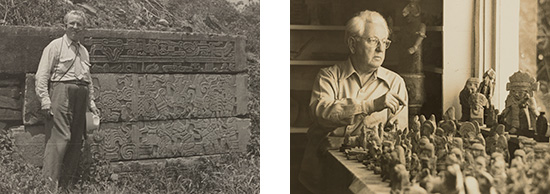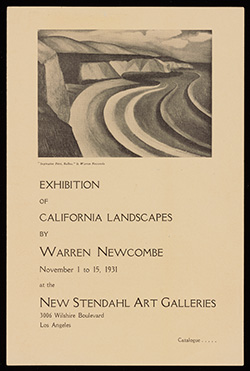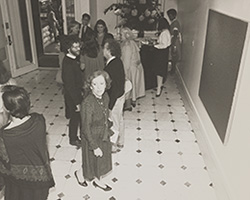Latin American Dealer Archives
Stendahl Art Galleries records
Clara Diament Sujo papers
|
The Research Institute has acquired two significant archives related to Latin American art. The gift of the Stendahl Art Galleries Archive provides insights on US interest in pre-Hispanic and modern Latin American art since the late 1930s through correspondence with institutions, private collectors, artists, and other dealers, while the donation of the papers of Clara Diament Sujo, an influential dealer, art critic, and promoter of Latin American art, illuminates the establishment of a significant Latin American art market in the United States beginning in the 1980s.
|
Stendahl Art Galleries Records
|
Earl Stendahl (1887–1966) was a pioneering American art dealer who in 1911 founded the influential Stendahl Art Galleries in Los Angeles, initially focusing on California impressionists of the early 20th century such as Nicolai Fechin, Joseph Kleitsch, Edgar Payne, Guy Rose, and William Wendt. The gallery eventually expanded its scope to include works by European and Latin American modern artists such as Constantin Brâncuși, Marc Chagall, Lorser Feitelson, Wassily Kandinsky, Paul Klee, Henri Matisse, Diego Rivera, and David Alfaro Siqueiros. Stendahl was a pioneer in the promotion of abstract art in California in the late 1920s. In 1939 he hosted one of only two non-museum exhibitions of Pablo Picasso's masterwork, Guernica, to benefit Spanish war orphans.
|

|
|
Stendahl worked with significant collectors including George Gershwin, William Randolph Hearst, Vincent Price, Nelson Rockefeller, David O. Selznick, and Frank Lloyd Wright. During the mid-1930s, Diego Rivera's pre-Hispanic art collection inspired Stendahl to start working with pre-Columbian objects from the Americas. The first clients for ancient artifacts from Mexico and Central America were the Los Angeles collectors Louise and Walter Conrad Arensberg, who became friends with Stendahl as he assisted them in putting together one of the most significant private collections in North America. As evidenced in the archival materials, Stendahl traveled extensively throughout Latin America both for research purposes and in pursuit of pre-Hispanic objects for his clients.
|
The Stendahl archive includes correspondence with institutions, collectors, artists, and dealers—most dating from the 1940s and 1950s—as well as significant photographic materials, pricing records, and appraisal information. All of these documents and images primarily relate to pre-Hispanic objects, showcasing Stendahl's efforts to position pre-Hispanic art in US museums and private collections. At the same time, they provide insight on the provenance and pricing history of the objects. Together with the donation of the Clara Diament Sujo Archive, the Stendahl Art Galleries Archive significantly bolsters the Research Institute's holdings related to the contemporary Latin American art market in the United States and complements existing collections at the Institute related to ancient archaeological sites in Latin America, including the Augustus and Alice Dixon Le Plongeon photographs of Chichén Itza, Uxmal and Yucatán; photographic albums on pre-Hispanic sites by French archaeologist Désiré Charnay and British diplomat Alfred Percival Maudslay; and travel books by Prussian geographer and explorer Alexander von Humboldt.
| ||||||
Clara Diament Sujo Papers
|
The Clara Diament Sujo Archive documents the emergence of the postwar generation of Latin American artists in the American market and, through extensive correspondence, reveals this Argentinean-born gallerist's relationship with museums, collectors, and artists such as Roberto Aizenberg, Josef Albert, Jacobo Borges, Pol Bury, Alejandro Otero, and Armando Reverón. Sujo was the founder and director of CDS Gallery in New York (1981–2011), originally known as Estudio Actual in Caracas (1968–1981), which began as a nonprofit institution dedicated to showcasing international modern and contemporary art through the exhibition of critically acclaimed artists such as Marisol, Marcel Duchamp, Robert Rauschenberg, and Jesús Soto. In 1981 Estudio Actual moved to New York and began activities as CDS Gallery, opening with a show of major North American artists (Philip Guston, Robert Motherwell, Jackson Pollock, Mark Rothko, and Clyfford Still) and Latin American masters (Wifredo Lam, Roberto Matta, José Clemente Orozco, Diego Rivera, and Joaquín Torres-Garcia). Sujo was instrumental in the organization of the first-ever auction of Latin American art at Sotheby's, New York in 1979.
|
Complementing Sujo's archive are original editions and unique research materials including notes and transcripts related to the seminars and lectures of renowned art critic Jorge Romero Brest, a key figure in the development of avant-garde practices in Argentina and their internationalization; an almost complete set of Brests Ver y Estimar journal; as well as 27 works on paper—the majority personally dedicated and given to Sujo—by artists such as Roberto Aizenberg, Josef and Annie Albers, Jose Luis Cuevas, Melvin Edwards, Mercedes Pardo, and Hedda Sterne. The autographed works showcase Sujo's close relationship to Latin American, North American, and European artists. Especially noteworthy are the nine illustrated letters created between 1958 and 1977 by Mexican artist José Luis Cuevas, who was one of the leaders of La Ruptura, the generation of artists who challenged the dominant movement of Mexican muralism in the 1950s and generated a personal style tied to expressionist forms.
| ||||||



